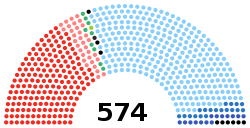Legislature I of Italy I legislatura della Repubblica Italiana | |
|---|---|
| 1st legislature | |
| Type | |
| Type | |
| Houses | Chamber of Deputies Senate of the Republic |
| History | |
| Founded | 8 May 1948 |
| Disbanded | 24 June 1953 (5 years, 47 days) |
| Preceded by | Constituent Assembly |
| Succeeded by | II Legislature |
| Leadership | |
List
| |
| Structure | |
| Seats | 574 (C) 343 (S) |
 | |
Chamber of Deputies political groups | |
 | |
Senate political groups | |
| Elections | |
| Proportional | |
| Proportional | |
Last general election | 18 April 1948 |
| Meeting place | |
| Palazzo Montecitorio, Rome (C) | |
| Palazzo Madama, Rome (S) | |
| Website | |
| First Legislature – Chamber of Deputies First Legislature – Senate | |
| Constitution | |
| Constitution of Italy | |
The Legislature I of Italy (Italian : I Legislatura della Repubblica Italiana) was the 1st legislature of the Italian Republic, and lasted from 8 May 1948 until 24 June 1953. [1] [2] Its composition was the one resulting from the general election of 18 April 1948.








